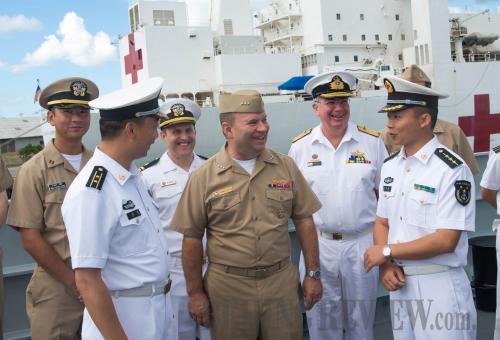|
 |
|
TOTAL TRANSPARENCY: Vice Admiral Kenneth E. Floyd (center), Commander of the U.S. Third Fleet, visits Chinese Navy missile destroyer Haikou on June 28 in Hawaii (QIN HAISHI) |
China sent a fleet to the Rim Pacific Exercise (RIMPAC) in June, marking the country's first involvement in the world's biggest marine military drill, headed by the United States. The drill has provided an opportunity for Beijing and Washington to enhance their military communication and mutual trust.
To reach the common goal of building a new-type relationship between major powers that can benefit world peace and stability, China and the United States should release more positive messages rather than animosity.
China's debut
This year's RIMPAC is held from June 26 to August 1 with participants from 23 nations.
According to Zhao Xiaogang, drill director of the Chinese fleet, the Chinese Navy is scheduled to participate in exchange events from June 25 to July 8, including press conferences, visits of warships, basketball and football matches and a 5-km cross-country race. During the maritime drills on July 9 to 30, the Chinese vessels will jointly conduct weapons firing, supplies sea-lifting, damage control, anti-piracy and disaster-relief operations as well as coordinated interceptions and landings, and joint assaults by warships and ship-borne helicopters, he said. With a fleet of over 1,100 naval soldiers and officers, the Chinese fleet is now the second biggest after the U.S. Navy in this year's RIMPAC.
Zhang Junshe, a researcher with the People's Liberation Army (PLA) Naval Military Studies Research Institute, pointed out that the scale and active involvement of the Chinese fleet indicate that military-to-military relations between China and the United States are building momentum since the summit attended by Chinese President Xi Jinping and his U.S. counterpart Barack Obama last summer.
"The United States showed a good posture of ameliorating bilateral military relations," said Zhang, adding Chinese and U.S. naval chiefs made a joint decision for the former's involvement.
RIMPAC generally includes several levels. Core subjects, which are completed jointly by the U.S. Navy and its allies like the United Kingdom, Japan, Australia, South Korea and Canada, cover fields with actual combat like joint anti-ship and anti-submarine operations, integrated air and marine defense, joint air strikes and amphibious warfare. General subjects, which are conducted by nations that are neither enemy nor friend of the United States, focus mainly on nontraditional security fields like humanitarian assistance, maritime search and rescue, anti-terror and anti-piracy. Peripheral countries participate in subjects such as sea queuing, reviewing troops and telecommunications, while observers merely watch and emulate.
Zhao said that the Chinese Navy hoped to achieve three goals in the drill: To push forward the healthy and stable development of bilateral new-type military relations, to deepen professional communication and practical cooperation with navies of other nations, and to demonstrate the PLA's determination and ability to protect world and regional peace, security and stability.
Deputy Commander of the Chinese Navy Xu Hongmeng stressed that China's involvement in RIMPAC is an important part of efforts to build a new model of relations between China and the United States and their militaries.
Zhang believed that as China and the United States now have more chances to interact in the Pacific region, China's involvement in RIMPAC is necessary to strengthen communication, prevent misjudgment and jointly protect regional peace and stability. "The U.S. side is showing a good gesture of communication, and China shows more confidence and openness by accepting the invitation," said Zhang.
Military-to-military contact has long been considered as the weakest link in the China-U.S. relationship. The two sides have held frequent high-level exchanges, including the exchange visits by defense chiefs in 2013, a rare search-and-rescue exercise in Hawaii and a second joint anti-piracy drill in the Gulf of Aden.
| 